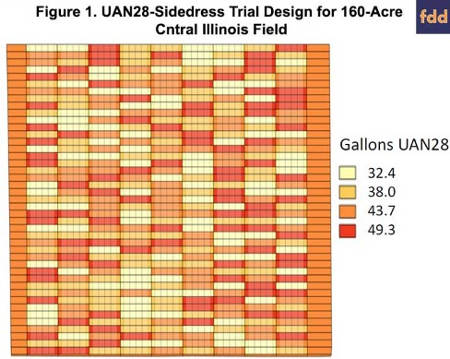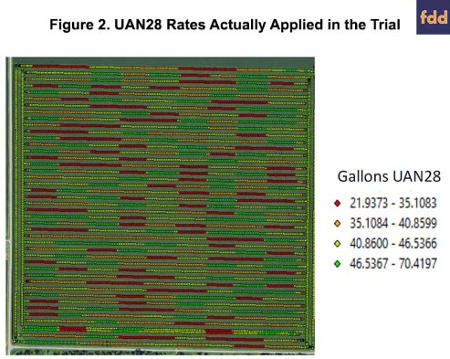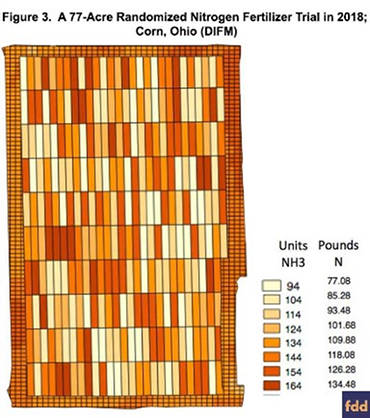By Jonathan Coppess and David Bullock
Department of Agricultural and Consumer Economics
University of Illinois
Nutrient loss in modern farming is a challenge that sits at the intersection of food production and the impacts of food production on natural resources (farmdoc daily, February 26, 2016; March 17, 2016). Agricultural research represents an investment in solving such challenges through basic and applied research efforts, the results of which can be translated to farmers and industry through demonstration and outreach (farmdoc daily, August 23, 2018). This article reviews USDA-funded agricultural research seeking to apply data, technology and a full range of science to the challenge of managing farm nutrients.
Background
A key component of the strategy to reduce nutrient loss is improving the application of fertilizers, particularly nitrogen in corn production (Sela and van Es, 2018; Morris et al., 2018). Known as the “4Rs” approach to nutrient management, the framework looks to the right source of fertilizer, applied at the right rate or amount, the right time and in the right place for the crop as a method to help reduce losses (Nutrient Stewardship). Failure to adhere to the 4Rs can result in fertilizer not being consumed by the growing crop and the residual nutrients in the field after harvest are very susceptible to being exported from the field and lost to waterways. Tile-drained fields lose on average nearly half of the nitrogen remaining after harvest, but can lose as much as 85% (Greer and Pittelkow, 2018; Lory and Scharf, 2003). Achieving each corner of the 4R strategy is particularly challenging given the vast uncertainties caused by the weather, especially precipitation, given its influence on both crop growth (nutrient consumption) and nutrient loss from leftover nutrients (Morris et al., 2018, at 27).
Growing corn requires a lot of nitrogen but the actual amount needed is highly variable from year-to-year, field-to-field and even within fields, depending on soils and weather (Lory and Scharf, 2003). If the farmer applies too much nitrogen some of it will be lost, but if the farmer applies too little nitrogen yields will likely be hurt which impacts revenue and profit. One factor further complicating nutrient management in the field are the significant unknowns and variability regarding the amount of nitrogen in the soil that can be used by the crop and how much may be mineralized from soil organic matter for future use (Morris et al., 2018). It requires accurate soil testing as well as modeling that can predict nutrient availability and uptake, all of which is complicated and full of uncertainty. For example, past research has found that some soils in the Corn Belt can provide 40 pounds of nitrogen per acre but it varied from as much as 100 pounds per acre for highly productive soils to less than 50 in poorer soils; more available after soybeans which fix nitrogen from the atmosphere in the soil and less after corn which consumes nitrogen (Camberato, 2015).
Nitrogen is critical to corn production and humans have added a lot of nitrogen to the environment. Some research has found that humans have increased the amount of nitrogen by 100% compared to pre-industrial levels (Keeler et al., 2016). In 2011, for example, researchers concluded that nearly 12 million tons of nitrogen were used by U.S. farmers but that only about half of the applied nitrogen was used by the growing crops (Asci, Borisova and VanSickle, 2015, at 251). One big concern for farmers and researchers involves the methods for determining the recommendations to farmers about how much nitrogen to apply.
Discussion
Historically (from 1970 to 2005), the basic method for farmers in applying nitrogen was a yield-based recommendation; estimate yield under ideal conditions and apply N fertilizer at 1.2 times that grain yield (Rodriguez, Bullock and Boerngen, 2018; Morris et al., 2018). If the farmer, for example, expected 200 bushels per acre in a field then this rule would advise the application of 240 pounds of nitrogen per acre in the field. Subsequent research has concluded, however, that expectations for corn yield is not an effective method for nitrogen recommendations (Morris et al., 2018). Recent research calls into question the original research and the validity of the conclusions that supported the 1.2 yield recommendation (Rodriguez, Bullock and Boerngen, 2018).
Since 2005, recommendations in the seven states of the Corn Belt have used the Maximum Return to Nitrogen (MRTN) method (Rodriguez, Bullock and Boerngen, 2018; Morris et al., 2017). MRTN demonstrates progress in nitrogen recommendations largely because recommendations are based on corn yield response research, as well as economics and profitability analysis, rather than simple yield goals (Morris et al., 2018). Many universities, as well as some commercial software, continue to use yield-based methods for providing nitrogen recommendations, however (Rodriguez, Bullock and Boerngen, 2018). The efforts to create economically optimal nitrogen rates have significant drawbacks, including that they are based on after-harvest data when, for example, the weather and production conditions are known; farmers will not know weather and growing conditions in advance.
In 2016, The National Institute of Food and Agriculture (NIFA) through the competitive research funding of the Agriculture and Food Research Initiative (AFRI), awarded a grant to a group of researchers led by David Bullock at the University of Illinois at Urbana-Champaign for a project titled, “Using Precision Technology in On-Farm Field Trials to Enable Data-Intensive Fertilizer Management” (Grant No. 2016-68004-24769). At $4 million in funding, the grant is for research through February 2020 that seeks to apply precision agricultural technologies that were developed using full-field, on-farm agronomic trials to improve the application rate for nitrogen fertilizers (UIUC-ACES, May 10, 2016). In short, the research seeks to develop better fertilizer recommendations based on agronomic experiments and statistical analysis techniques. More importantly, it seeks to make use of modern precision farming and data analytics to conduct randomized on-farm field trials.
Figures 1 through 3 provide examples of the randomized on-farm field trials using the software and statistical analysis method; more information can be found on the project’s website (DIFM). Figure 1 is the trial design for nitrogen application (side dress) and Figure 2 is the actual applied, randomized nitrogen in a central Illinois field. Each set of bocks by color in the design is a different application rate. Figure 2 illustrates the accuracy of the machine in matching to the trial design, as well as what the randomized trial for nitrogen rates looks like on the field. Figure 3 is an example of a randomized nitrogen field trial in Ohio. One outcome of these randomized trials is that yields can be compared against nitrogen application rates across the field.



The DIFM project conducted approximately 40 randomized field trials in 2018. The goal of properly-designed trials such as these is to better account for the impacts on crop yields from both variations in growing conditions (e.g., soils, weather, etc.) but also different management decisions. The research may be able to better untangle the impacts on yields that can be attributed to weather or soil from those attributed to management practices such as nitrogen application. Results could help improve the methodology for providing nitrogen recommendations and advance towards the 4R goals for reducing nutrient losses from farming.
Concluding Thoughts
A challenge as vast and complicated as reducing nutrient losses from farming will require substantial research and should be helped by advances in technology and data analytics. It will also require significant efforts to translate that research through outreach, demonstration and Extension; feedback from the experiences and interactions on the ground valuable for further research questions and agendas. Even the best research, data and analysis, however, will be left with substantial uncertainties because of unpredictable weather. Such unpredictability may become more complicated under climate change scenarios (IPCC). It may be that the best we can do is to better understand the variables we know, continue to research the ones we do not and always be ready, able and willing to adapt to changing circumstances and understandings; fitting, in fact, for farming.